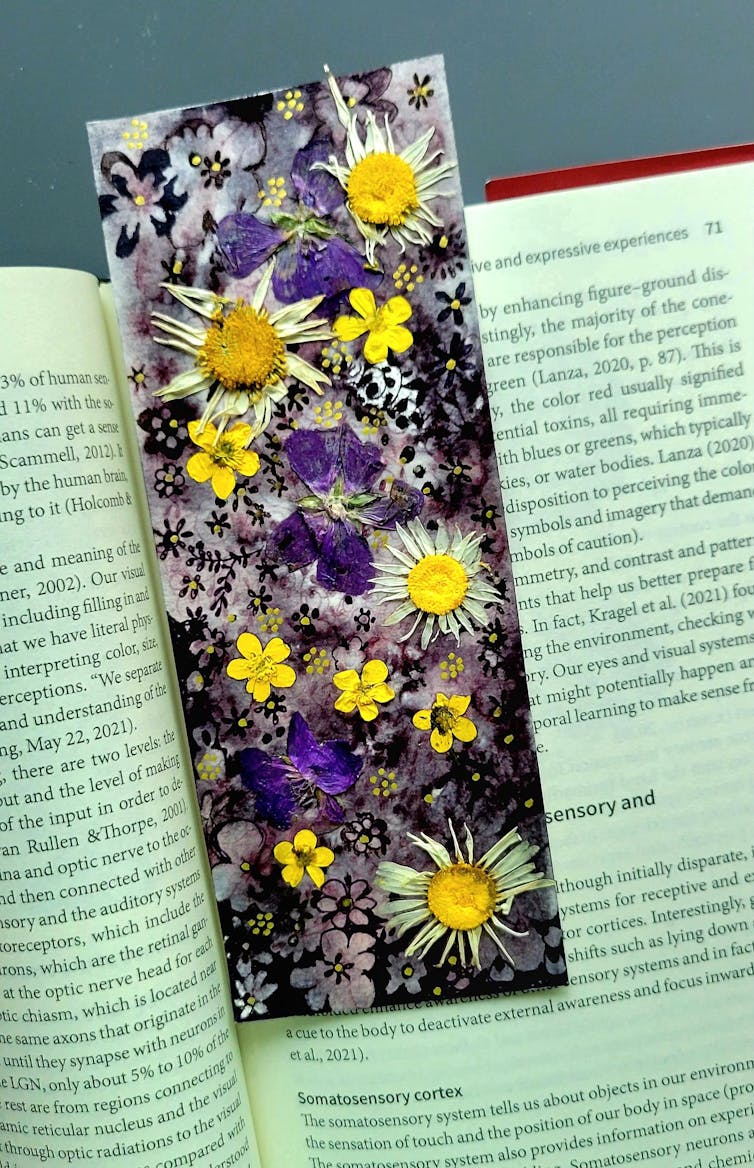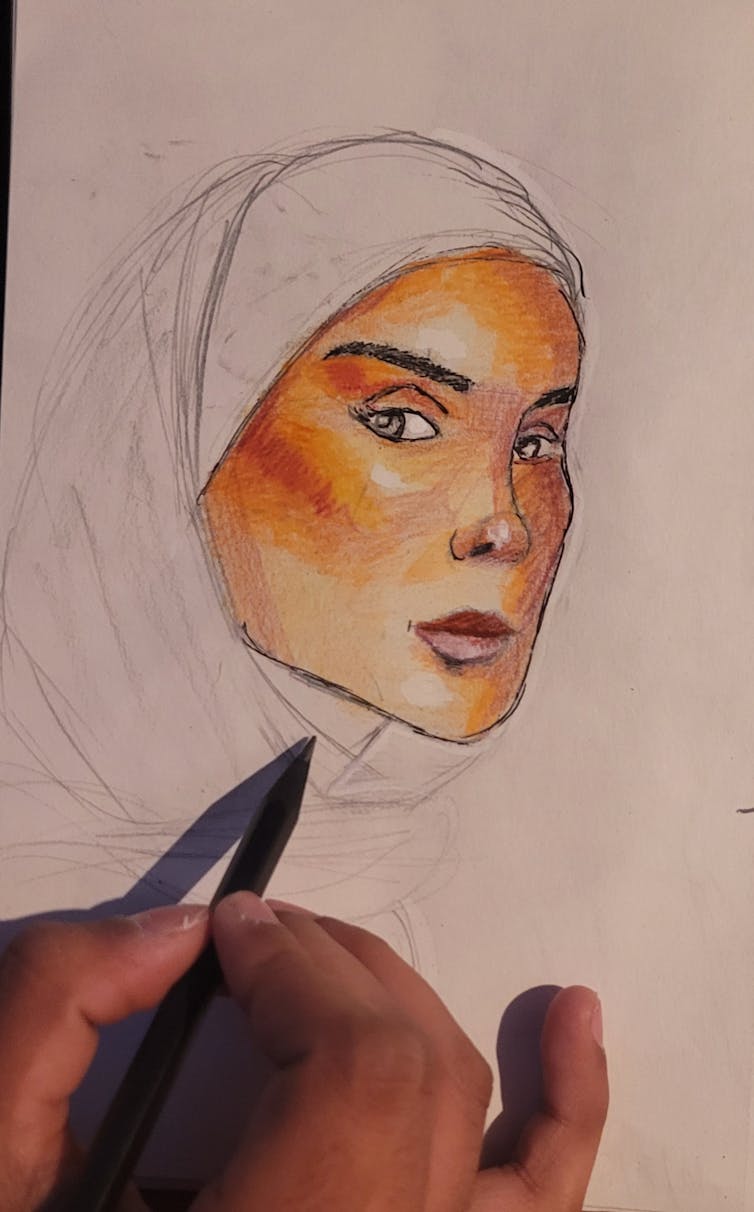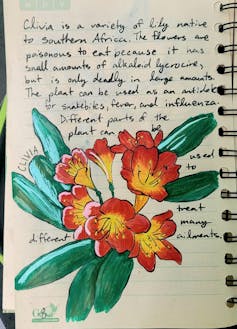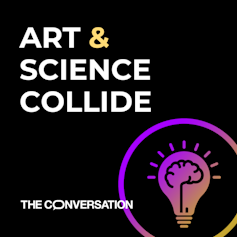When you think of the word “art,” what comes to mind? A child’s work of art pinned to the refrigerator? A favorite artist whose work always inspires? Abstract art that is difficult to understand?
Each of them assumes that making art is something other people do, like children or “the talented.”
However, as I explain in my book “The Expressive Instinct,” art is intrinsic to human evolution and history. Just as sport or physical training exercises the body, creating art exercises the imagination and is essential for mental and physical well-being.
I am an art therapy instructor who studies how creative self-expression affects physical and emotional health. In our clinical research studies, my colleagues and I have discovered that any form of creative expression – including drawing, painting, fiber arts, woodworking or photography – can reduce stress, improve mood and increase self-confidence.
As a sick child who often needed to stay home from school, I found that making art helped me cope. Today, artistic creation is my sanctuary. I use it as a sounding board to better understand myself and as a way to recharge and learn from life’s challenges.

Girija Kaimal
The specifically human attribute of creativity
Although everyone has their own idea of what defines art, one thing is universally true: creativity is a defining characteristic of the human species.
How so? Well, human brains are not computers that process data. They are biological prediction machines that perceive the environment through memory and the senses, with the ability to use this information to imagine plausible future scenarios.
These inherent predictive and imaginative abilities are the source of humanity’s ability to survive and thrive – because self-expression is a safety valve that helps us cope with uncertainty. No one really knows the future; they have to live each day without being sure of what will happen tomorrow. Art can help us all exercise that imaginative muscle in useful ways.
In our study examining brain activity when using virtual reality tools to create 3D digital artwork, my team demonstrated that creative expression is a natural state of being. The brain naturally uses fewer cognitive resources to be expressive and creative, compared to the brain power needed to perform a repetitive task that requires conscious effort.
Seemingly ordinary everyday activities can provide opportunities to tap into a person’s natural creativity and imagination: making a meal from leftovers, finding an alternate route to work, dancing a little jig in response to a song, or planting and tending a garden.
We’ve found repeatedly in our studies that even just one session of real, honest speaking can improve self-confidence and reduce feelings of stress, anxiety, and burnout.
This is partly because creativity activates reward pathways in the brain. Using our hands and body to express ourselves activates dopamine pathways and helps us feel good. Dopamine is a neuronal messenger associated with feelings of hope, accomplishment or reward. Our brains are wired to release feel-good hormones every time we move, create something, or engage in any type of expressive activity.
Tapping into inner creative resources is one of the world’s most underrated seeds of well-being.
In comparison, repressing or denying these feelings can cause distress, anxiety, and fear because we have not processed and expressed them. This is probably one of the reasons why every community around the world has its own creative and expressive practices. Even our ancestors in indigenous communities around the world intuitively knew that self-expression was essential to emotional health and social connections.
Not being able to share our lives, keeping secrets, and feeling isolated and alone tend to worsen our health. To our brain, social isolation feels like a chronic illness because it interprets this loneliness and inability to express itself as a threat to survival.
Since creative expression can appeal to the senses, it can also be a bodily workout: a sensual but also emotional and cognitive experience. Being active in expression – whether art, music, dance, drama, writing, culinary arts or working with nature – imparts a sense of confidence and the hope that challenges can be overcome and overcome.

Then Ahuja
The role of art therapy
Given the essential role of art in our lives, it makes sense that creating art can help people deal with transitions, adversity and trauma, like the stress of puberty, the death of a loved one or serious illness.
According to a global study, 1 in 2 people will face a mental health challenge in their lifetime, whether it be life challenges, genetic predispositions, or a combination of both.
This is where art therapy can come in. Art therapy is a regulated mental health profession in which clinical psychotherapists with extensive clinical training provide psychotherapy to patients with diagnosed mental health needs.
The origins of art therapy date back to attempts to treat soldiers suffering from post-traumatic stress during the two world wars of the 20th century. There is now evidence that traumatic experiences tend to be stored as sounds, images and physical sensations in the brain. When a person lacks the words to process these experiences through traditional talk therapy, art therapy can provide an indirect way to express and externalize these feelings and memories.
One of the unique strengths of art therapy is that it offers nonverbal means of communicating, treating, and potentially managing the symptoms of post-traumatic stress disorder, or PTSD. In fact, in a recent study, my team found that a personal history of trauma is linked to how people respond to evocative images. Images of distress and pain resonate with us when we have experienced similar types of distress ourselves. This implies that our life stories make us aware of the distress of others and even personalize it more.
Creative self-expression is particularly relevant to coping with trauma because it provides a means by which a person can regain a sense of agency and control.

Then Ahuja
How to bring creativity into everyday life
For those who discover art as a creative activity or for reasons of well-being, engaging in creative activities begins with letting go of unrealistic expectations. Being creative is not about becoming a famous or even mediocre artist. It’s about allowing us to flex the creative muscle we all possess and enjoy all the sensory and emotional aspects of imagination.
Next, think about the activities that allowed you to explore freely as a child. Did you like to sing, play outside, dance, invent plays or write short stories? Allow yourself to indulge in all those creative activities that made you feel relaxed and joyful.
A cultural tradition, tinkering with electronics, giving someone a gift or simply paying attention to the beauty of everyday life: each of these activities can be a creative activity. And like any muscle, the more you exercise it, the stronger it becomes. Over time, you will notice that you become more confident and more adventurous in your creative practices.
Either way, make time for this creative pursuit each week – which is probably the hardest step of all. If it seems “unimportant” compared to the demands of daily life, like work or family, try thinking of it as another form of sustenance.
Remember, creativity is just as essential to human health as eating nutritious meals or getting exercise and rest. So, as the Latin saying goes: “Plene vivere”. Live fully.

This article is part of Art & Science Collidea series examining the intersections between art and science.
You may be interested:
Literature Inspired My Medical Career: Why the Humanities Are Needed in Healthcare
I wrote a children’s play about integrating the arts into STEM fields – here’s what I learned about interdisciplinary thinking
Intertwined art and science: This course explores the long, interrelated history of two ways of seeing the world